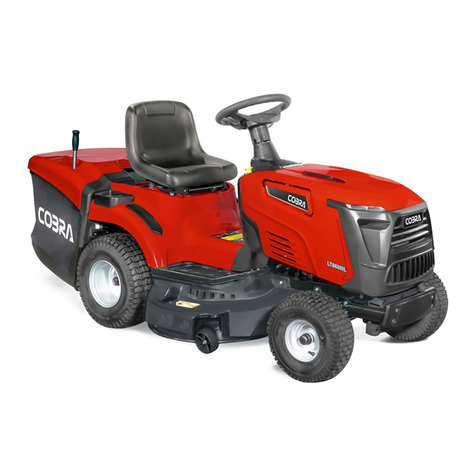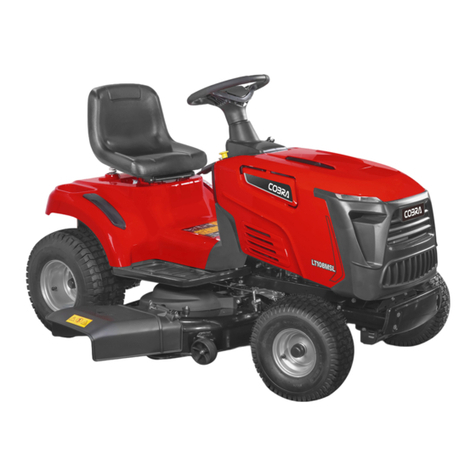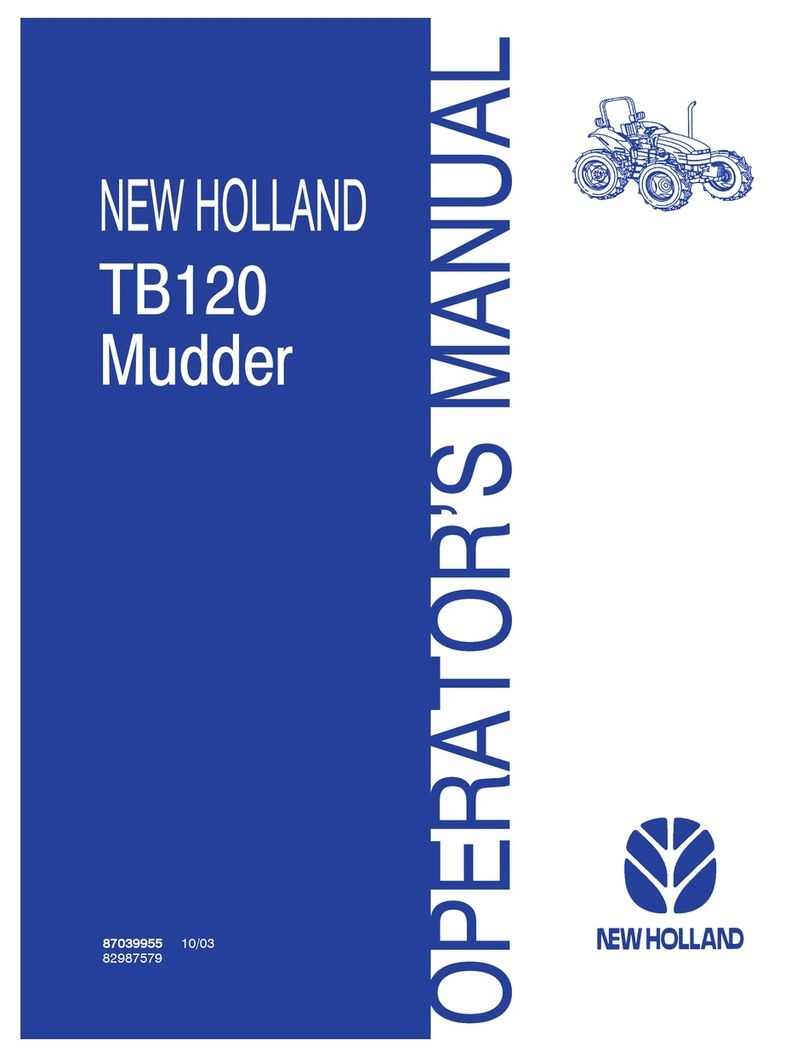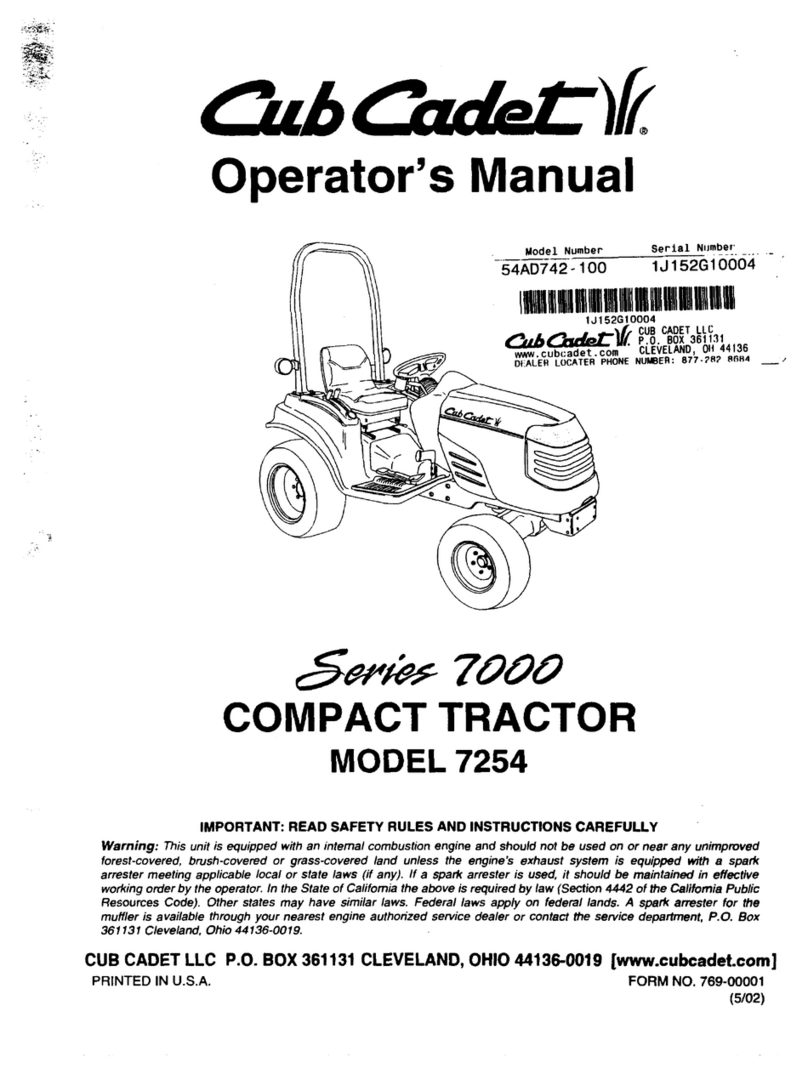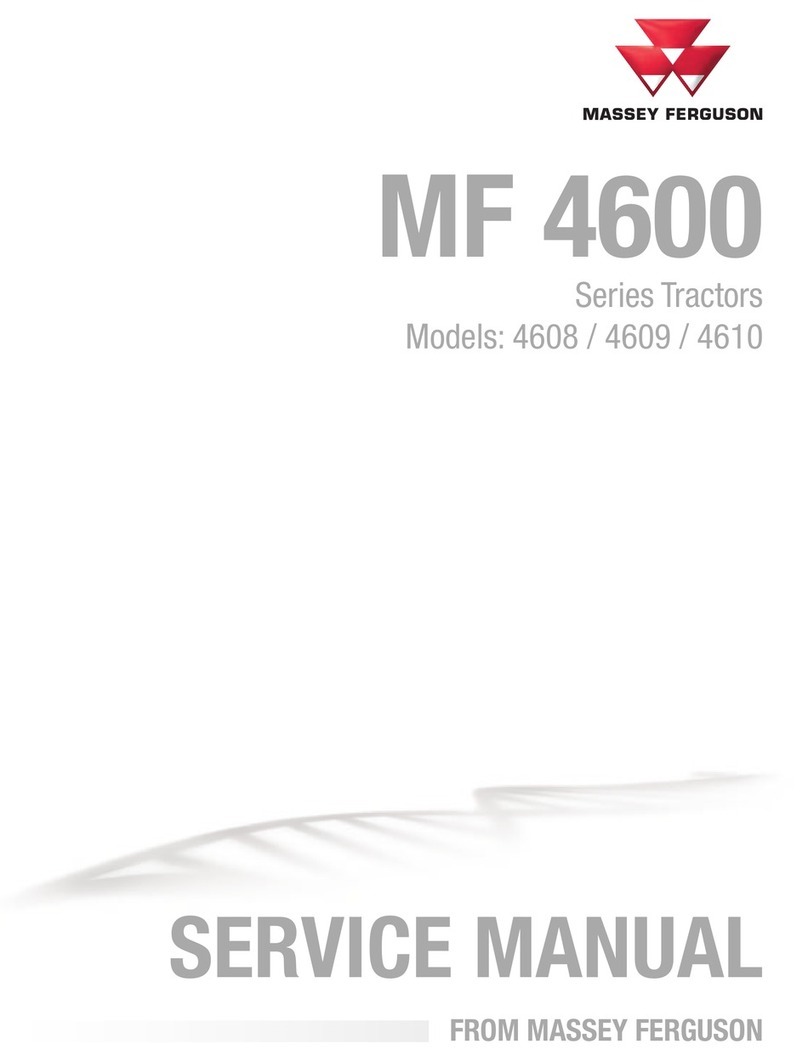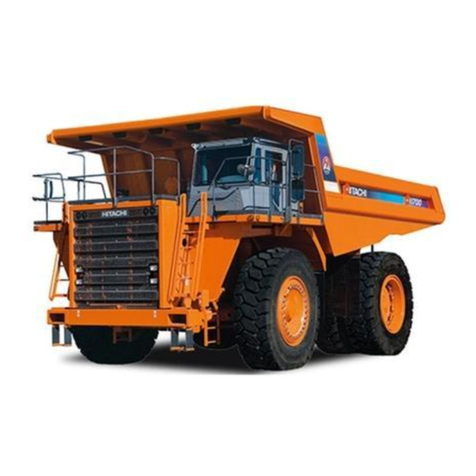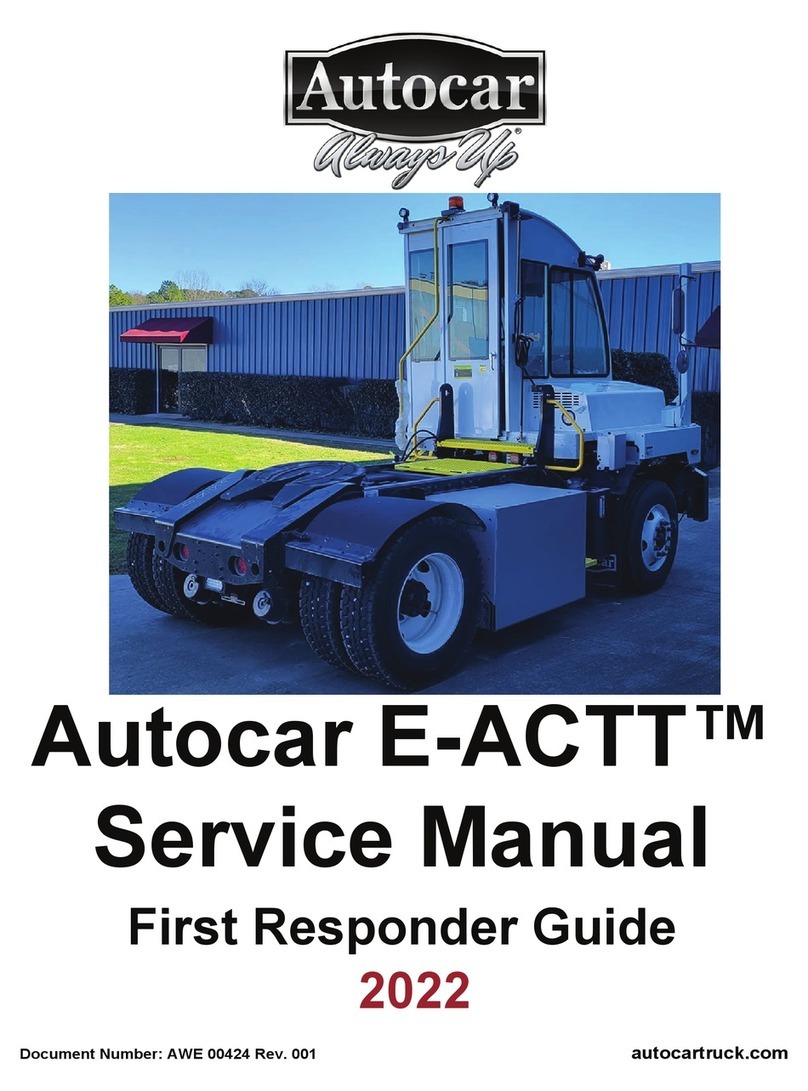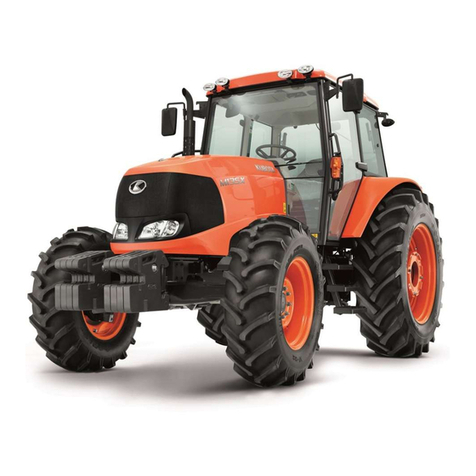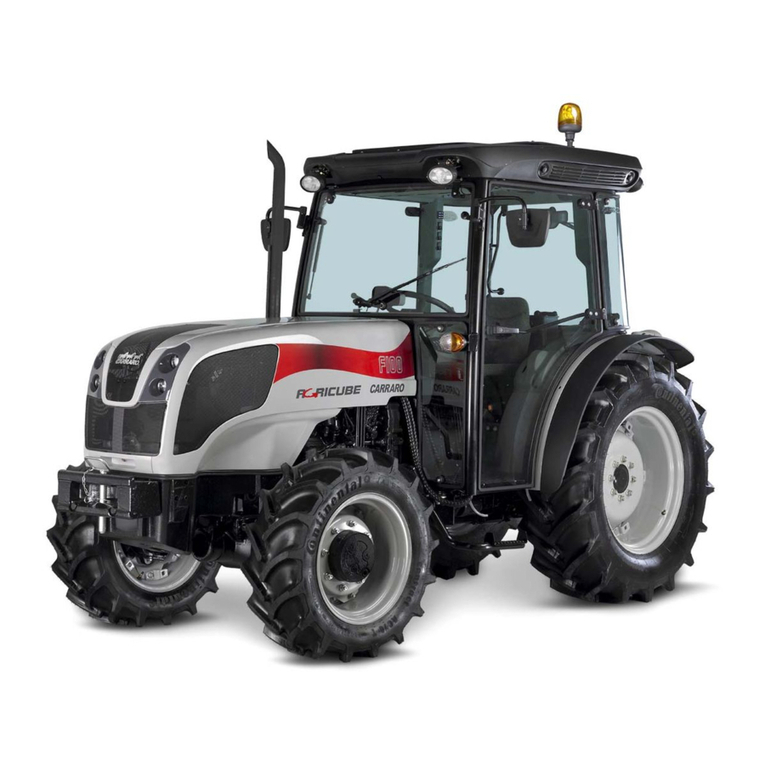Cobra LT62MRL User manual

1
COBRA GARDEN TRACTOR
OWNER’S MANUAL
MODEL: LT62MRL (TRM162-L224)
LT62HRL (TRM162H-L224)
WARNING!
When using the machine the safety rules must be followed. For your own safety and bystanders please read these instructions before
operating the machine. Please keep the instructions safe for later use.
Cobra Garden Machinery
Henton and Chattell Ltd., London Road, Nottingham NG2 3HW UK
www.cobragarden.co.uk

2
INTRODUCTION
Dear Customer,
Thank you for choosing a Cobra garden machinery product.
This manual has been written to help you become familiar with the machine and use it safely and efficiently. Do not forget that
it is an integral part of the machine, so keep it close at hand for future reference and pass it on to the purchaser if you sell the
machine.
The garden tractor has been designed and built in compliance with current standards, and is safe and reliable when used for
cutting and collecting grass following the instructions in this manual. Always follow the instructions to ensure safe operation. If
you use the machine in any other way or ignore the instructions for safe use, maintenance and repair, it is considered
"incorrect usage". In this case, the warranty is automatically voided and the manufacturer will not be held responsible for
damage or injury to yourself or others.
We continuously improve our products and as such minor modifications may result in slight differences between your garden
tractor and the instruction manual. Modifications can be made to the machine without notice and without the obligation to
update the manual, although the essential safety and function characteristics will remain unaltered. If in doubt, do not hesitate
to contact your dealer. And now enjoy your Cobra garden tractor.
AFTERSALES SERVICE
This manual gives all the necessary instructions for using the machine and carrying out basic maintenance.
Any adjustments or maintenance operations not described in this manual must be carried out by your dealer or a
specialised Service Centre. Both have the necessary knowledge and equipment to ensure that the work is done correctly
without affecting the safety of the machine.
This will help you keep your new purchase in peak performance and maintain its value over time.
For any replacement parts, contact your Cobra dealer.
WARNING LABELS

3
TABLE OF CONTENTS
1.
SAFETY................................................................................................................................4
2.
IDENTIFICATION
OF
THE
MACHINE
AND
COMPONENTS
............................................................8
3.
UNPACKING AND ASSEMBLY ...........................................................................................10
4.
CONTROLS AND INSTRUMENTS.......................................................................................11
5.
CHECKS BEFORE USE INSTRUCTIONS ..............................................................................17
6.
OPERATING THE RIDE-ON MOWER.................................................................................19
7.
CLEANING THE RIDE-ON MOWER ...................................................................................24
8.
MAINTENANCE.................................................................................................................25
9.
TRANSPORT......................................................................................................................28
10. STORAGE ........................................................................................................................29
11. TROUBLESHOOTING.......................................................................................................29
12. TECHNICAL DATA ...........................................................................................................32
13. WARRANTY ....................................................................................................................34
14. EC DECLARATION ...........................................................................................................35

4
IMPORTANT
1.SAFETY
1.1HOW TO READ THE MANUAL
Some paragraphs in the manual containing important information regarding safety and operation are emphasised in
the following ways.
or These give details or further information on what has
already been said, in the aim to prevent damage to the machine.
Non-observance will result in the risk of injury to oneself or others
Non-observance will result in the risk of serious injury or death to oneself or others
Positions refer such as “front”, “back”, “left” or “right” hand side, refer to forward travel direction.
For all operations regarding the use and maintenance of the engine not described in this manual, refer to
the relevant manuals which form an integral part of all the documentation supplied with the machine.
1.2 GENERAL SAFETY REGULATIONS
Read carefully before using the machine.
A) TRAINING - Read the instructions carefully.
Be familiar with the controls and how to use the equipment properly.
–Never let children or people unfamiliar with these instructions use the machine. Local regulations can restrict the
age of the user.
–Never mow while people, especially children, or pets arenearby; Never mow while dark.
–Keep in mind that the operator or user is responsible for accidents or hazards occurring to other people or
their property.
–Do not carry passengers.
–All drivers should seek and obtain professional and practical instruction. Such instruction should emphasise:
–the need for care and concentration when working with ride-on machines;
–you cannot use the brake to regain control of a ride-on machine sliding down a slope.
The main reasons for loss of control are:
–insufficient wheel grip;
–over-speeding;
–inadequate braking;
–the type of machine is unsuitable for its task;
–unawareness of the effect of ground conditions, especially slopes;
–incorrect hitching and load distribution
NOTE

5
B) PREPARATION
While mowing, always wear sturdy footwear and long trousers. Do not operate the equipment barefoot or
wearing open sandals. Thoroughly inspect the area where the equipment is to be used and remove all objects
which can be ejected from the machine, such as twigs, branches, stones, and other debris.
DANGER! Petrol is highly flammable:
–store fuel in containers specifically designed for this purpose;
–refuel outdoors only and do not smoke while refueling;
Add fuel before starting the engine. Never remove the cap of the fuel tank or add petrol while
the engine is running or when the engine is hot;
–if you spill petrol, do not start the engine and move the machine away from the area of spillage. Do
not create any source of ignition until the petrol vapors have evaporated;
–put back and tighten all fuel tank and container caps securely.
- Replace faulty silencers.
- Before use, always inspect the machine to check that the blades, blade bolts and cutter assembly are
not worn or damaged. Replace worn or damaged blades and bolts in sets to preserve balance.
- On multi-bladed machines, remember that the rotation of one blade can cause other blades to rotate.
NOTICE! –Always check the engine oil is the correct level before starting. Check the engine manual for further
details.
C) OPERATION
1) Do not start the engine in a confined space wheredangerous carbon monoxide fumes can collect.
2) Mow only in daylight or good artificial light.
3) Before starting the engine, disengage the blades and shift into neutral.
4) Do not use the machine on slopes with longitudinal gradients of more than 15°(27%). Do not use the
machine on slopes with lateral gradients above 10°(18%).
5) Remember there is no such thing as a “safe” slope. Travelling on grass slopes requires
particular care.
To guard against overturning:
–do not stop or start suddenly when going up or downhill;
–engage the drive slowly and always keep the machine in gear, especially when travelling downhill;
–machine speeds should be kept low on slopes and during tight turns;
–stay alert for humps and hollows and other hidden hazards;
–never mow across the face of the slope.
–use care when pulling loads or using heavy equipment:
–use only approved drawbar hitch points;
–limit loads to those you can safely control;
–do not turn sharply. Use care when reversing;
–use counterweight(s) or wheel weights whenever advised in the instructions manual.
6) Stop the blades before crossing surfaces other than grass.
7) Never use the machine with damaged guards, or without the safety protective devices in place.
8) Do not change the engine governor settings or overspeed the engine. Operating the engine at excessive
speed can increase the risk of personal injury.
9) Before leaving the driving seat:
-disengage the blades and lower the attachments;

6
–go into neutral and apply the parking brake;
–stop the engine and remove the ignition key.
10) Disengage the blades, stop the engine and remove the ignition key:
–before clearing blockages or unclogging the collector channel;
–before cleaning, checking or servicing the machine;
–after striking a foreign object. Inspect the machine for damage and make repairs before restarting and operating
the machine;
–If the machine starts to vibrate abnormally (check for the causes immediately).
11) Disengage the blades for transport or whenever they are not in use.
12) Stop the engine and disengage the blades:
–before refueling;
–before making height adjustments unless adjustment can be made from the operator’s position.
13) Reduce the throttle during engine run-out. If the engine is provided with a shut-off
14) Cut off the fuel with the fuel valve when you have finished mowing.
15) Watch out for traffic when crossing or near roadways.
16) Never direct discharge of material towards bystanders nor allow anyone near the machine while in
operation.
D) MAINTENANCE AND STORAGE
1) Keep all nuts, bolts and screws tight to be sure the equipment is in safe working condition.
2) Never store the equipment with petrol in the tank inside a building where fumes may reach an open flame or
spark.
3) Allow the engine to cool before storing in any enclosure.
4) To reduce fire hazards, keep the engine, silencer, battery compartment and petrol storage area free of
grass, leaves, or excessive grease.
5) Check the grass-catcher frequently for wear or deterioration.
6) Replace worn or damaged parts for safety purposes.
7) If the fuel tank has to be drained, this should be done outdoors.
8) On multi-bladed machines, remember that the rotation of one blade can cause other blades to rotate.
9) When the machine is to be parked, stored or left unattended, lower the cutting means unless a positive
mechanical lock is used.
1.3 SAFETY LABELS
Your machine must be used with care. This is why labels with illustrations have been placed on the machine, to
remind you of the main precautions to take during use. These labels are to be considered an integral part of the
machine. Should a label come off or become illegible, contact your dealer to replace it. Their meaning is explained
below.
Warning:
Read the instructions before
operating this machine.
Warning:
Disconnect the ignition key and read the
instructions before carrying out any repair
or maintenance work.
Danger!
Dismemberment:
Make sure that children stay clear of the
machine at all time when engine is running.
Danger!
Risk of burns
Wait for the engine to completely cool down
before making any adjustments or servicing the
engine itself.

7
Warning:
No step on the deck or discharge guard.
Warning: Do Not Step
Danger: Ejected Objects
Always operate with the grass catcher or
discharge guard in place
Danger: Risk of Injury
Keep bystanders away
Blades continue to rotate after switching
off the engine or disengaging the blade.
Warning: Keep hands and feet away
from blades
Warning:
Never use a pressure washer on the
transmission system.
Danger: Risk of overturning on steep slopes
Do not use the machine on slopes with a gradient
greater than 8 degrees (15%).

8
2.
IDENTIFICATION
OF
THE
MACHINE
AND
COMPONENTS
IMPORTANT
The lawnmower must always be used with utmost caution. So that safety precautions and operating instructions are always
readily on hand, labels have been affixed to the machine showing pictographs illustrating the main operating precautions. The
labels, according to applicable safety standards, are considered an integral part of the machine, the user is therefore
responsible for replacing them in the event they become detached or illegible.
1 Steering wheel 7 Bonnet
2 Safety sticker 8 Mower mechanism
3 Operator's seat 9 Cleaning fitting
4 Grass catcher 10 Front wheels, steered
5 Selector lever 11 Mower mechanism lever
6 Release lever for reverse gear 12 Brake pedal

9
COMPONENT / PARTS DESCRIPTION
13 Lever for grass catcher 21 Cable starter handle
14 Throttle lever with choke 22 Rear wheels, driven
15 Ignition lock 23 Discharge channel
16 Locking lever for brake/clutch pedal 24 Bypass lever
17 Forwards pedal 25 Fill level sensor
18 Reverse pedal 26 Engine cover
19 Enable button for reverse mowing 27 Brake/clutch pedal
20 Adjusting lever for cutting height

10
3. UNPACKING AND ASSEMBLY
For storage and transport purposes, some components of the machine are not installed in the factory and have to
be assembled after unpacking.
Follow the instructions below:
The machine is supplied without engine oil or fuel. Before starting the engine, fill with oil and fuel
following the instructions given in the engine manual.
3.1 UNPACKING
When unpacking the machine, take care to gather all individual parts and fittings, and do not damage the cutting
deck when taking the machine off the pallet.

11
4.
CONTROLS AND INSTRUMENTS

12

13

14

15
4.1THROTTLE LEVER (Fig. 3A.)
Adjusting the throttle will change the speed of the ride-on mower.
This regulates the engine revs and speed. The positions are indicated on a label showing the following symbols:
«CHOKE» cold starting
«SLOW» for minimum engine speed
«FAST» for maximum engine speed
The «CHOKE» position enriches the mixture so must only be used if necessary when starting from cold.
4.2 IGNITION KEY SWITCH (Fig. 4)
0Select this key position for ‘Engine Off’. The ignition key may be removed in this position.
I Key position for engine running, after starting.
II Turn the key to the ‘Start’position for starting the engine. Release the key as soon as the engine is running. It then springs
back to operating position I.
4.3 MANUAL:BRAKE/CLUTCH PEDAL (Fig. 5), HYDRSTATIC:BRAKE PEDAL (Fig. 6)
Brake
- For the manual transmission: Press the brake/clutch pedal (Fig. 5.1) all the way down (a), the drive is disengaged and the brake
on the transmission is applied.
- For the hydrostatic transmission: If you press the brake pedal (Fig. 6.1) all the way down (a), the brake on the transmission is
applied.
The ride-on mower brakes / Parking brake
- With manual transmission: Pulling the locking lever (Fig. 5.2) upwards (b) while the brake/clutch pedal (Fig. 5.1) is pressed
down locks the brake.
-With the hydrostat transmission: Pulling the locking lever (Fig. 6.2) upwards (b)
To release the brake - Press the pedal again
WHEN STARTING: The brake/clutch pedal must be pressed down all the way.

16
4.4 MANUAL GEARBOX OPERATION [SELECT DRIVING SPEED]
4.4.1 Operating the manual transmission (Fig. 3, 5, 7)
The manual gearbox transmission of the ride-on mower has four forwards gears and one reverse gear.
The gears can be selected using a selector lever (Fig 3.B and Fig. 7.2) on the left of the operator's seat, according to the required
driving speed.
When Starting the engine
The selector lever must be in the N position (Fig. 7.3), i.e. neutral, to start the engine.
NOTE - The mower cutting mechanism must be disengaged to start the engine.
Selecting a gear
1. Press the brake/clutch pedal (Fig. 5.1) down all the way when the engine is running.
2. Pull the locking button (Fig.7.1) on the selector lever (Fig. 7.2) all the way up.
3. Select the gear appropriate to the required direction of travel and driving speed.
4. To start moving off, slowly release the brake/clutch pedal (Fig.5.1). Releasing the pedal quickly may cause the engine to stall or
the mower may move abruptly.
NOTE
If you want to select a lower gear than the one that is engaged, first brake to reduce the speed of the ride-on mower until the
speed matches the corresponding gear.
4.4.2 Operating the hydrostatic transmission (Fig. 3, 8)
On ride-on mowers with hydrostatic transmission, there are two separate pedals on the right-hand side for forwards and reverse
travel.
Direction of travel
Description
Forwards
Press the front pedal (Fig.8.2) to drive forwards.
Reverse
Press the rear pedal (Fig.8.3) to drive backwards.
Note: The speed is limited when the mower cutting
mechanism is switched on.
Mowing in reverse (see chapter 7.6.2"Mowing in reverse"
Starting to Move off
With The engine is running then:
1. Release the parking brake (Fig. 3.E, Fig. 8.1).
2. Select the direction of travel (Fig. 3.F).
Increasing the speed
Depress the pedal further down to increase the speed in the selected direction. Lift off the pedal to reduce drive speed.
4.5 OPERATING THE MOWER CUTTING BLADE MECHANISM (Fig.9, 10)
Setting the cutting height
The ride-on mower's mower cutting height can be set to various heights using an adjusting lever (Fig.9.2) , located right next to
the operator's seat.
1. Press the release button (Fig. 9.1) on the adjusting lever (Fig. 9.2) (Fig. 9.a).
2. Move the adjusting lever in the required direction (Fig. 9.b):
- Lever downwards: lowers the cutting height
- Lever upwards: raises the cutting height
When switching on the mower cutting mechanism
1. Set the highest cutting height with the adjusting lever (Fig. 9.2).
Note: The mower cutter mechanism must always be started at the highest cutting height.
2. Pull the lever (Fig. 10.1) for switching on the mower mechanism upwards (Fig. 10.a) and engage it (Fig. 10.b). The mower
cutting blades will be running.
3. Set the required cutting height with the adjusting lever (Fig. 9.2).

17
5 CHECKS BEFORE USE INSTRUCTIONS
STOP –Danger –Only operate the ride-on once fully assembled –follow the assembly instructions
- Ensure the assembly has been completed, the oil level is correct and safety devices operate correctly before use.
5.1 CHECKING THE MOWER CUTTING MECHANISM
Wear heavy duty gloves and proceed with care. Check the mower blade, securing bolts and mower deck before using.
Replace worn blades and parts. Damaged components should be renewed. Blades that are not balanced will increase vibration
and cause damage to the ride-on tractor.
5.2 CHECK AND FILL ENGINE OIL AS NECESSARY (Fig. 11, 12)
NOTE
The engine is shipped with the oil drained. Fill and check oil levels before starting. Refer to the engine manual.
Check the engine oil routinely and add oil as necessary.
Fill the engine oil using a funnel or filler pipe. Do not allow oil to spill on the engine, tractor or ground.
1. Fold the seat (Fig. 11/1) forwards and open the cover (Fig. 11/2) to the engine compartment (Fig. 11/a).
2. Unscrew the oil filler neck (Fig. 12/1) cap.
3. Check and pour in oil (Fig. 12/a) until the oil level can be seen between the MIN and MAX marks on the oil dipstick (Fig.
12/2). Do not overfill the engine.
4. Screw the oil filler neck (Fig. 12/1) cap on again.
5. Close the cover (Fig. 11/2) to the engine compartment and fold the seat (Fig. 11/1) back.
5.3 FUEL FILLING (Fig. 11, 13)
Handle Fuel with Caution –Follow the instructions.
Petrol is highly inflammable. Fill the tank outdoors in a well-ventilated area. Do not smoke whilst filling.
Allow the engine to cool before refueling. Do not refuel when the engine is running or it is hot.
For more detailed information, please refer to the separate operating instructions for the engine.
Use a suitable funnel or a filler pipe when refueling so that no fuel is spilled on the engine, tractor or the ground.
For safety reasons, the fuel tank cap and other tank caps must be renewed if damaged.
Do not start the engine if the fuel has overflowed. The ride-on mower must be removed from the area contaminated by fuel,
and the spilled fuel must be absorbed and wiped away from the ground, the engine and the deck using a cloth.
Do not start the engine until the fuel vapours have evaporated.
Keep fuel safely in containers solely for the purpose of storing petrol.
Use lead-free petrol, min. RON 91.
Filling the fuel tank
1. Switch off the engine and remove the ignition key.
2. The engine must cool before refueling, to reduce the risk of fuel igniting.
3. Fold the seat (Fig. 11/1) forwards and open the cover (Fig. 11/2) to the engine compartment (Fig. 11/a.)
4. Open the tank cap (Fig. 13/1) and pour the fuel into the tank (Fig. 13/2) (Fig. 13/a).
Note: Avoid overfilling the fuel tank
5. Close the tank cap (Fig. 13/1).
6. Close the cover (Fig. 11/2) to the engine compartment and fold the seat (Fig. 11/1) back.
5.4 Check tyre pressure (Fig. 14)
Check the tyre pressure at regular intervals. Please note, incorrect tyre pressures are essential for the a level cutting deck.

18
1. The ride-on should be parked on a firm and level ground and remove the ignition key.
2. The tyre should be allowed to cool down for about an hour after use. Only measure the tyres when cool.
3. Measure the tyre pressures carefully.
4. The tyre pressures should be 1.0 –1.4 bar.
5. Inflate or deflate as necessary.
PLEASE NOTE 1 PSI = 0.07 bar.
5.5Attaching and removing the grass collector (Fig. 15)
Attaching the grass catcher
1. Fit the hooks (Fig. 15/1) of the grass catcher (Fig. 15/2) into the brackets (Fig. 15/3) on the ride-on mower (Fig. 15/a). Grip the
grass catcher by the handle (Fig. 15/4) and the side facing away from the ride-on mower.
Note: The grass collector must be fitted symmetrically / level.
2. Tilt the grass catcher downwards (Fig. 15/b) until it engages on the ride-on mower.
3. Check the grass catcher is correctly seated.
To Remove the grass catcher
Simply reverse the procedure above to remove the collector.
5.6 Checking the safety devices
Check the safety devices correctly before starting the ride-on mower.
Danger when checking the safety devices!
Caution: Only check the safety devices from the operator’s seat. Keep other people and animals a safe distance away.
Check on a level surface so that the ride-on mower cannot roll away.
5.6.1 Checking the brake system contact switch (Fig. 03, 04)
The engine should only start when the brake is engaged. Follow the procedure below to check that the switch operates correctly.
The engine must be off before testing.
1. Sit on the operator's seat.
2. Release the parking brake by applying the brake/clutch pedal (Fig. 03/G) or the brake pedal (Fig. 03/E).
3. Release the brake/clutch pedal or the brake pedal again.
4. Attempt to start the engine, i.e. ignition key in position II (Fig. 04).
NOTE - The engine should not start without the brake engaged. Contact a service dealer if the engine starts
during the test.
5.6.2 Checking the mower cutting mechanism contact switch
The engine should not with the cutting blade engaged. Check the safety switch operates correctly as follows:
The engine must be off before testing.
1. Sit on the operator's seat.
2. Apply the brake/clutch pedal or the brake pedal (see section 5.3 "Brake/clutch pedal (Fig. 05), brake pedal (Fig. 06)"
3. Engage the mower cutting mechanism (see "Operating the mower mechanism (Fig. 09,10)").
4. Attempt to start the engine, i.e. ignition key in position II (Fig. 04).
NOTE - The engine should not start with the cutting blade engaged. See a service dealer if the engine starts
during the test.

19
5.6.3 Checking the seat contact switch (Fig. 16)
The ride-on tractor has a contact switch for the seat (Fig. 16/1), this ensures that the engine cuts off when nobody is on the
operator's seat when the mower cutting mechanism is switched on or when the parking brake is not locked.
1. Sit on the operator's seat.
2. Apply the brake/clutch pedal or the brake pedal (see section 5.3 "Brake/clutch pedal (Fig. 05), brake pedal (Fig. 06)").
3. Start the engine and let it run at maximum rpm (see section 7.4 "Starting and shutting off the engine").
4. Engage the mower mechanism (see section 5.5 "Operating the mower mechanism (Fig. 09, 10)").
5. Lift yourself off the seat by standing up. It is not necessary to get off the tractor.
NOTE - The engine will switch off when leaving the seat. See a service dealer if the engine continues to run.
5.6.4 Checking the grass catcher contact switch (Fig. 17, 18)
The grass collector contact switch ensure the engine cuts out if the collector is not in place correctly, whilst the blades are
working. The grass collector contact switch is located where the collector fits (Fig. 17/1).
1. Sit on the operator's seat.
2. Apply the brake/clutch pedal or the brake pedal (see section 5.3 "Brake/clutch pedal (Fig. 5), brake pedal (Fig. 06)").
3. Start the engine and let it run at maximum rpm (see section 7.4 "Starting and shutting off the engine").
4. Engage the mower cutting mechanism (see section 5.5 "Operating the mower mechanism (Fig. 09,10)").
5. Raise the empty grass catcher (Fig. 18/1) slightly (Fig. 18/a) (see section 7.6.4 "Emptying the grass catcher (Fig. 22, 23)").
NOTE - The engine must switch itself off. See a service dealer if the engine continues to run.
5.6.5 Mower cutting mechanism and belt covers visual check
The mower cutting mechanism and belt covers should be undamaged to prevent access to the belts, pulleys and blade. Replace
safety covers. Refer to the service dealer if repairs are required.
6OPERATING THE RIDE-ON MOWER
All operators must read and have adequate knowledge before using the ride-on mower.
Read and adhere to all safety instructions. Make sure the tractor is prepared correctly. All safety devices operate correctly.
See a service dealer for further assistance before operating if any safety devices do not function correctly, guards are missing or
the ride-on vibrates.
6.1 Key steps before starting
- Wear appropriate footwear and long trousers. Never mow barefoot or with open sandals.
- Check the mowing area. Remove all stones, sticks, wires and other debris from the lawn, which may be thrown from the
mower. Continue to check whilst mowing.
- Complete all checks and steps outlined in the previous section. Do not use the tractor if any of the safety devices are not
operating correctly.
- Do not carry objects on the ride-on.
6.2 Caution when using accessories
Danger due to incorrect accessories or incorrect use of accessories!
Only ever use safe and reliable accessories, ideally recommended by the manufacturer. Check that the accessory is safe to use.
Using unsafe accessories, or using accessories incorrectly, can expose the operator and other persons to significant risks. The
ride-on mower could be overloaded. This can lead to serious accidents.

20
6.3 Caution when pushing the ride-on mower (Fig. 03, 19)
Danger when pushing on slopes!
Caution: Do not push the ride-on on slopes. It is only safe to push the tractor on flat level areas. The tractor may run away on
slopes.
Steps to push the ride-on with manual transmission
1. Release the parking brake (Fig. 03/G) (see chapter 5.3 "Brake/clutch pedal (Fig. 05), brake pedal (Fig. 06)").
2. Move the gear selector lever (Fig. 03/B) to the N position.
Steps to push with hydrostatic transmission
The bypass lever (Fig. 19/1) is located at the rear in the lower area of the rear wall. Bypass release:
1. Pull out the bypass lever (Fig. 19/1).
2. Release the parking brake (see section 5.3 "Brake/clutch pedal (Fig. 05), brake pedal (Fig. 06)",). The ride-on mower can now
be pushed.
3. After pushing, reset the bypass lever (Fig. 19/1) to enable the hydrostatic transmission again.
6.4 Starting and shutting off the engine
Engine Starting
1. Sit on the operator's seat.
2. Fully depress the brake/clutch pedal (Fig. 05/1) or the brake pedal (Fig. 06/1) and lock it with the locking lever (Fig. 05/2,
06/2).
3. Make sure the mower cutting mechanism is not switched on. To do this, check the position of the lever (Fig. 03/D).
4. With manual transmission: Make sure that the selector lever (Fig. 03/B) is set to the N position (neutral). To do this, check
the position of the gear selector lever.
5. Move the engine speed controller (Fig. 03/A) to the front end stop. The hare symbol is located there.
6. Insert the ignition key into the ignition lock (Fig. 04/1).
7. Starting the engine (electrically):
- Turn the ignition key to position "II" and hold it there until the engine is running (Fig. 04).
Note: Do not hold the start position for longer than 5 seconds. Pause before attempting start again.
- Release the ignition key; it automatically returns to position "I".
8. Starting the engine (with pull cord starter):
If the engine cannot be started with the electric starter, check the ride-on mower for mechanical damage. If there is no
damage, the engine can also be started with the pull cord starter.
- Turn the ignition key to position "I" (Fig. 04).
- Pull the cable starter (Fig. 20/1) straight out quickly and forcefully 3 to 4 times until the engine is running.
9. Move the engine speed controller (Fig. 03/A) to the operating position.
To switch off the engine
1. Shut off the mower cutter mechanism (Fig. 03/D).
2. Move the engine speed controller (Fig. 03/A) to the neutral position.
3. Fully depress the brake/clutch pedal (Fig. 05/1) or the brake pedal (Fig. 06/1) and lock it with the locking lever (Fig. 05/2,
06/2).
4. Turn the ignition key (Fig. 04/1) to the "0" position.
5. Remove the ignition key.
Danger the engine and exhaust will be hot after use.
Be careful to consider if combustible items may catch fire if near to the ride-on.
6.5 Driving with the ride-on mower
Danger - use a slower speed
Drive slowly, especially at the beginning, in order to familiarise yourself with the driving and braking behaviour of the
ride-on mower.
This manual suits for next models
1
Table of contents
Other Cobra Tractor manuals
